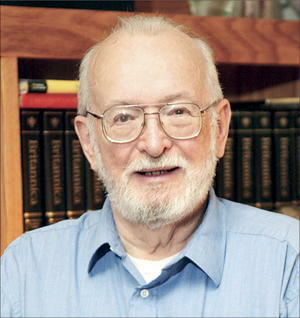Paul Lauterbur to be inducted into Engineering & Science Hall of Fame

Paul C. Lauterbur, an Illinois professor of chemistry who was awarded a Nobel Prize in 2003 for his pioneering work in the development of magnetic resonance imaging, has been chosen to be inducted (posthumously) into the Engineering and Science Hall of Fame.
The Engineering and Science Hall of Fame is an international organization established to honor engineers and scientists who, using scientific and engineering principles, have made a significant contribution to human well-being. Lauterbur will be inducted at a ceremony on Thursday, November 9.
He was among the first scientists to use nuclear magnetic resonance spectroscopy in the study of molecules, solutions and solids. In the early 1970s he began applying the same technology to biological organisms. As in other NMR experiments, Lauterbur put his subjects - he first used a clam - inside a powerful magnetic field and collected the resulting radio signals that were emitted by atomic nuclei within the tissues. He discovered that using a static magnetic field and varying the intensity of a second magnetic field across his subjects yielded clearer signals, allowing better imaging of different tissues.
Lauterbur shared the Nobel Prize for physiology or medicine with Sir Peter Mansfield of the University of Nottingham in England. Mansfield, a physicist, improved the utilization of magnetic gradients and showed how the resulting signals could be mathematically analyzed.
Lauterbur, who was born May 6, 1929, in Sidney, Ohio, earned a doctorate in chemistry from the University of Pittsburgh in 1962 and a bachelor's degree in chemistry in 1951 from Case Institute of Technology, Cleveland.
He was a professor in the department of chemistry at the State University of New York at Stony Brook from 1963 to 1985, when he joined the faculty of the University of Illinois College of Medicine. In his 22 years at the U. of I., Lauterbur also had appointments or affiliations with the Center for Advanced Study, the Beckman Institute, the department of electrical and computer engineering and the department of physiology and biophysics (now two units: the department of molecular and integrative physiology and the Center for Biophysics and Computational Biology). At the time of his death, he was a Center for Advanced Study professor of chemistry, biophysics and computational biology and bioengineering. He also was the Distinguished University Professor of Medical Information Sciences.
Published November 03, 2017 04:15